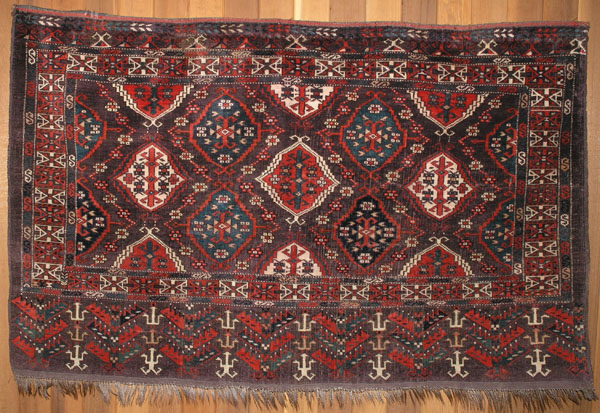
Home Page Discussion
The Salon du Tapis d'Orient is a moderated discussion group in the manner of the 19th century salon devoted to oriental rugs and textiles and all aspects of their appreciation. Please include your full name and e-mail address in your posting.
Mini-Salon 23: Is this a Chodor (A)Juval; (B)Trapping?; (C)Both; (D)Neither?
by Steve Price
Considering the fact that the Chodor were a major Turkmen group, it's a little surprising that there are so few Chodor weavings in publications, exhibitions, museums or private collections. The small number of published Chodor pieces surely accounts in part for the sparse occurrence of Chodor trappings in publications. For example, there are two in Mackie and Thompson's Turkmen (Plates 49 and 50). Thompson believes that they are trappings because of their extraordinary size (1'9" x 5'8" and 1'6" x 5'4", respectively). This seems reasonable, although some Ersari torbas and juvals (clearly bags, since they have backs) approach such dimensions. Jim Allen has speculated that some juvals serve heraldic functions as well as being containers (that is, that they were juvals AND trappings), although I don't recall his suggesting that some juval format weavings were strictly trappings, not containers at all.
Date attribution is problematic in all Turkmen groups, but awareness of this seems to be more open in writings about Chodor work than in writings about any other Turkmen group. John Howe summarized the situation in an attribution guide that he wrote for Turkotek. Kurt Munkacsi's article on Chodor bags in HALI (77, p. 96, 1994; reproduced on Thomas Cole's site) is one of the very few in the rug literature in which an author attempts to generate principles for attributing dates to the weavings of a specific Turkmen group without confounding the facts with the arguments based on them.
I am introducing a Chodor piece with what appears to be a juval format, but I suspect that is a trapping. If it is, a number of other Chodor "juvals" may be trappings, too.

The color rendition on my monitor is fairly accurate overall, although the red is a bit more orange and the ground color a bit more purple in person. The dimensions are 4'6" x 2'10"; the width of most Chodor juvals is less than 4 feet. The knots are asymmetric (open right), moderately finely woven (14 knots per inch vertically x 9 per inch horizontally; 126 kpsi overall), with little or no warp depression. The wool has excellent tactile qualities, quite unlike the relatively rough feel of the wool in much late 19th century Chodor work. There is pink silk pile in the horizontal "S" figures in the guard borders at the bottom, and in several places in the elem. Silk pile is relatively uncommon in Chodor weavings. The bottom end has the warps grouped and knotted. This could not have been possible with a juval, since the plainweave back is continuous with the bottom of the pile face. On the other hand, this may be a juval on which several inches of the back was left in place when the back was cut off, the wefts removed from most of the remaining back, and the exposed warps gathered into groups and knotted. Munkacsi classified Chodor weavings on the basis of the interior elements of the blue guls; this specimen belongs to category I.
Here is Number 6 in Munkacsi's article in HALI. It is a fairly small illustration in the print version, and I was unable (or not clever enough) to get a scan that doesn't look oversharpened.

The similarity to my piece is obvious enough to make it reasonable to suppose that they were woven at about the same time and place. The dimensions are 3'7 x 2'7", typical for Chodor juvals. The stretching just to the left of the center suggests that it had been a container (juval). The knot density is 170 kpsi (17 vertical x 10 horizontal). Munkacsi estimates the time of weaving to be around 1830, partly on the basis of the Yomud inluence in the elem. His estimate may be spot on, although there were substantial populations of Yomud and of Chodor in and around Khorezm by about 1700.
I ran across one other Chodor piece with a strong family resemblance to the two shown above.

This was sold by a well known dealer within the past few years. Like mine, it is oversized relative to most Chodor juvals; the dimensions are 4'6" x 2'7". It shows signs of vertical stretching on the left side, suggesting use as a container rather than as a trapping.
I invite comments about anything relevant, but am especially interested in the issue of whether the Chodor wove trappings and, if so, how to identify them.
Finally, for those of you who (like me) enjoy fantasizing about the meaning and significance of motifs, these three pieces should keep you busy for a very long time. Here are a couple of closeups to help you get started.

